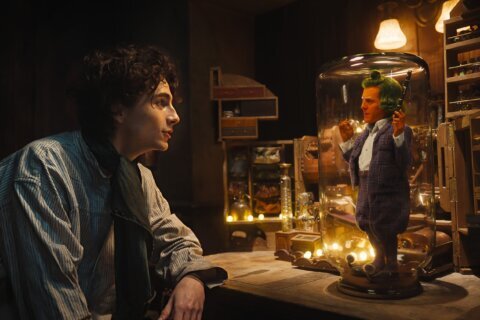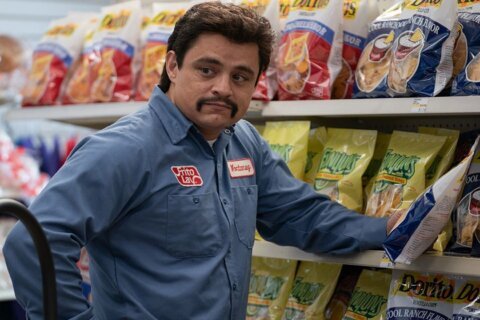WASHINGTON – Like a hand reaching up from the grave, “Carrie” is back from the dead. The horror genre has long provided a feeding frenzy for remakes, and despite a few rare exceptions — David Cronenberg’s “The Fly” (1986) and John Carpenter’s “The Thing” (1982) — it’s often a recipe for disaster.
In the last 15 years, we’ve seen “Psycho” (1998), “The Haunting” (1999), “House on Haunted Hill” (1999), “The Ring” (2002), “The Texas Chainsaw Massacre” (2003), “The Grudge” (2004), “The Amityville Horror” (2005), “The Fog” (2005), “House of Wax” (2005), “The Hills Have Eyes” (2005), “The Omen” (2006) and “When a Stranger Calls” (2006).
We’ve also seen “Night of the Living Dead 3D” (2006), “Black Christmas” (2006), “The Wicker Man” (2006), “Halloween” (2007), “The Hitcher” (2007), “The Invasion” (2007), “Prom Night” (2008), “Quarantine” (2008), “Shutter” (2008), “Friday the 13th” (2009), “Children of the Corn” (2009), “A Nightmare on Elm Street” (2010), “The Wolfman” (2010), “Let Me In” (2010), “The Thing” (2011), “Texas Chainsaw 3D” (2013) and “The Evil Dead” (2013).
Now, you can dump the remake blood on “Carrie.”
If you never saw the Brian DePalma flick, or read the Stephen King novel, you’re missing a supreme revenge fantasy and the greatest warning against bullying ever done. The remake again pits Carrie White (Chloe Grace Moretz) as a telekinetic teen, who’s bullied at school and crushed at home by a religious fanatic mother (Julianne Moore).
When jock stud Tommy Ross (Ansel Elgort) asks her to the senior prom, she worries it might be a trick. But the boy’s intentions really do seem genuine, despite a plot by other classmates to rig the vote, make her the prom queen, then drown her in a bucket of pig’s blood on stage in front of everyone.
Beyond contemporary references like Tim Tebow and “Dancing with the Stars,” the remake does have some things going for it in 2013. Digital effects enhance Carrie’s telekinetic powers, and the modern setting brings a poignant commentary on cyber bullying, piggy-backing off last year’s documentary “Bully” (2012) and a number of heartbreaking news stories of young girls taking their own lives.
While the digital bullies are more relevant, their target is not nearly as believable. Chloe Grace Moretz is so beautiful it’s hard to buy that she would be bullied like the boney-faced, wide- eyed Sissy Spacek, who had previously starred in Terrence Malick’s “Badlands” (1973) and designed sets with her art director husband on DePalma’s “Phantom of the Paradise” (1974). “Carrie” earned Spacek her first Oscar nomination, losing Best Actress to Faye Dunaway for “Network” (1976), before finally winning as Loretta Lynn in “Coal Miner’s Daughter” (1980).
Moretz has a ways to go before she reaches Spacek, but she does have some real potential. Just look at her emotional nostril flares upon learning she’s been named prom queen. I just wish her handlers would find her more original projects. So far, he recent credits include three horror remakes: the vampire movie remake “Let Me In” (2010), the vampire soap opera remake “Dark Shadows” (2012) and now the “Carrie” remake. Let’s see a little more “Hugo” (2011) and “500 Days of Summer” (2009).
Playing across from Moretz is the ever-talented Julianne Moore, who’s done horror reboots before, playing Clarice Starling in “Hannibal” (2001). Moore does her best to fill big shoes, as Piper Laurie was legendary as Spacek’s domineering mother. The Oscar-nominated role was a powerful comeback for Laurie, who had gone into a 15-year retirement after “The Hustler” (1961).
The rest of the supporting cast, including Alex Russell (“The Host”) and Gabriella Wilde (“The Three Musketeers”), can only hope to see the same benefit as the 1976 cast. The most famous case, of course, was John Travolta, who had played on TV’s “Welcome Back Kotter” (1975), but used “Carrie” to launch two box office titans in “Saturday Night Fever” (1977) and “Grease” (1978).
Corralling all these actors is director Kimberly Pierce, who directed Hillary Swank to an Oscar in the coming-of-age drama “Boys Don’t Cry” (1999) and introduced a crop of future stars in the war flick “Stop-Loss” (2008), from Ryan Phillipe to Joseph Gordon-Levitt to Channing Tatum.
Pierce is an inspired choice, with a feminine experience that can better relate to the themes of menstruation and prom queens than DePalma. Pierce’s vision shines in several moments. As Carrie gets dressed in the mirror, the camera tilts down and tilts back up to see her mother’s creepy reflection behind her. As she confronts the getaway car of her tormentors, faces smash through windshield glass with daring detail. And as Carrie returns home from the prom covered in blood, the camera turns 90 degrees sideways, her world literally turned upsidedown.
Pierce seems to go out of her way to change certain elements from the original, reviving the courtroom framing device from King’s novel, altering the final graveside jump-scare, and scrapping the outdated split-screens, which also hurt the climax of Robert Aldrich’s “The Longest Yard” (1974).
And yet, for all her filmmaking prowess, Pierce never quite matches DePalma, whose sights and sounds are so burned into our brains at this point, they seem just as “untouchable” as the film’s 1976 peers: “Rocky,” “Taxi Driver,” “Network,” “All the President’s Men,” “Marathon Man” and “The Omen.” Perhaps he was just keeping up with Avildsen, Scorsese, Lumet, Pakula, Schlesinger and Donner, but DePalma was never on his game like he was in “Carrie.”
“I can’t really think of any movie that I conceptualized so strongly visually and had so much time to play with the visual design before I shot it,” DePalma said.
I urge you to rent the original and find these directing techniques:
- DePalma shoots the locker-room shower scene in dreamlike slow-motion. The brief full-frontal nudity would resemble soft-core porn in any other format, but it feels beautiful here against the billowing shower steam and lullaby music, as the camera dollies past several rows of gym lockers, then pushes in on Carrie alone in the shower. With her leg lifted at a 90-degree angle, blood slowly drips down her leg, then through her fingers, causing her to drop the soap in slow-motion and be pelted with tampons in sheer bully isolation.
- DePalma employs masterful “mise-en-scene” inside Carrie’s home, a series of Gothic candles, crucifixes and steeple arches. A painting of the Last Supper hangs behind their dinner table, and a kitchen closet serves as a confessional, housing a religious doll that matches Piper Laurie’s exact posture in her ultimate crucifix fate.
- In many scenes, DePalma uses a “split-diopter lens” to have one side of the screen in focus in a close-up, while the other side of the screen is equally in focus in background. This helps show the emotional distance between Carrie (background) and her classmates (foreground).
- When Carrie and Tommy embrace for a magical prom dance, they stand on a turntable, as the camera circles them in a low-angle looking up at the papier-mache stars.
- As the fakes votes are tallied for prom queen, DePalma orchestrates a “Figure 8” single-take, starting on a single ballot, then following a girl from table to table collecting the remaining ballots. Without cutting, the camera reveals the pranksters under the stage, then cranes up to follow a rope all the way to the bucket of blood in the rafters, at which point we zoom toward Carrie and Tommy as they learn they’ve “won.” Producers urged DePalma to lose the shot, which took all day to get, but DePalma threatened to quit the picture. It was worth every penny, as the masterful single-take has since added to the allure of owning the DVD.
- Finally, in the film’s final scene, DePalma created a jump-scare that was not in King’s novel, but which King said he wished he had thought of: Carrie’s hand reaching up out of her grave like the end of “Deliverance” (1972). What makes the scene resonate all these years later is the way DePalma shot it, having the actress walk backwards on set, then reversing it to create a dreamlike effect to match the overexposed lighting. If you look closely, you’ll see that the cars in the background are moving backwards.
With all that said, it would be unfair to criticize Pierce as “unoriginal” compared to DePalma. Throughout the ’70s, he blatantly stole from Hitchcock, ripping “Rear Window” (1954) for “Sisters” (1973) and copying “Vertigo” (1985) for “Obsession” (1976). His best ’80s flick was “Scarface” (1983), a remake of Howard Hawks’ 1932 masterpiece, followed by “The Untouchables” (1987), which copied the staircase scene from Sergei Eisenstein’s “Battleship Potemkin” (1925). Even “Carrie” (1976) featured homages to “Psycho” (1960), from the aptly named Bates High School to the slashing strings each time Carrie uses her telekinesis.
While DePalma was no “originality” saint, he was a dutiful believer in the cinema prophets who came before him. “Carrie” remains his most organic work to date, perhaps because it was King’s debut novel and his first to be adapted for the screen. Without “Carrie,” we may never have seen “Salem’s Lot” (1979), “The Shining” (1980), “Christine” (1983), “Cujo” (1983), “Children of the Corn” (1984), “Stand By Me” (1986), “Pet Sematary” (1989), “Misery” (1990), “It” (1990), “The Shawshank Redemption” (1994), “The Green Mile” (1999) or “Under the Dome” (2013).
“I was surrounded by contemporaries that were George Lucas, Spielberg and Scorsese. They were having these tremendous successes in the same period, and I always thought of myself as, I was lucky to have this little horror film that had done well, so I could go on to make another one,” DePalma said. “I had no idea this would be thought of as a classic old movie years later.”
My advice: use your own form of telekinesis to slam the multiplex door on the 2013 remake, and send the 1976 classic flying into your Blu Ray player. You can find it on Amazon for $7.99, cheaper than a movie theater ticket, and get a better viewing experience in the process.
The original grossed $33.8 million at the box office, the equivalent of $221.8 million today, while the remake has grossed just $26.6 million since its release on Oct. 18. That means studios could have made another $200 million if they simply found the next great horror story from an up-and- coming horror novelist. Instead, they seem intent on losing money through remakes.
From box office dough, to critics reviews, Sissy Spacek won’t be bullied from her throne as cinema’s scream queen anytime soon.
“Carrie” (1976)
★ ★ ★ ★
“Carrie” (2013)
★ ★ 1/2
The above rating is based on a 4-star scale. See where this film ranks in Jason’s 2013 Movie Guide. Read more reviews on our “Fraley on Film” page. Follow WTOP Film Critic Jason Fraley on Twitter @JFrayWTOP, read his blog The Film Spectrum or listen Friday mornings on 103.5 FM.








